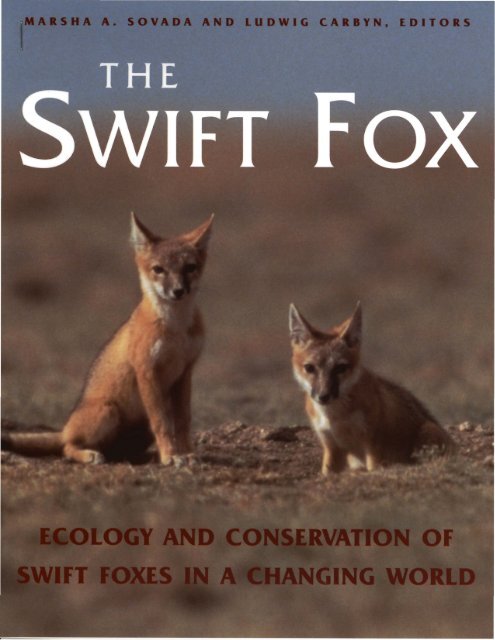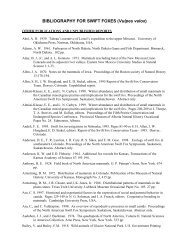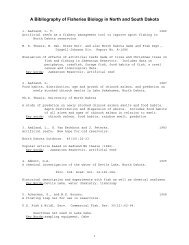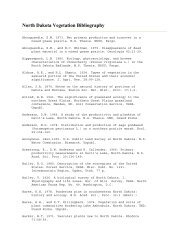PDF Download - Northern Prairie Wildlife Research Center
PDF Download - Northern Prairie Wildlife Research Center
PDF Download - Northern Prairie Wildlife Research Center
- No tags were found...
Create successful ePaper yourself
Turn your PDF publications into a flip-book with our unique Google optimized e-Paper software.
Sargeant, White, Sovada and Cypherrepresented a diversity of habitats, wildlife communities,and land management practices encountered within theranges of swift and kit foxes.Camp Roberts, California, encompassed 172 krn 2 ofrolling hills between the Salinas River floodplain and theSanta Lucia Mountains. Dominant vegetation includedgrassland, oak (Quercus spp.) woodland, and mixed chaparral:kit foxes, however, occurred primarily in grasslandand low- to medium-density oak woodland (Reese et al.1992). The NPRC was located 42 krn southwest ofBakersfield, in Kern County, and comprised 323 km 2 ofrolling hills dissected by steep draws and dry streamchannels. Vegetation consisted of xerophytic shrubs andpatchy herbaceous cover dominated by exotic annualgrasses and forbs. Study areas in Kansas encompassed259 km 2 each. One comprised relatively flat croplanddevoted primarily to production of winter wheat, corn,milo, sunflowers and sorghum. The other included rollinghills of moderately to heavily grazed pastures with a fewcultivated areas interspersed.Temperatures averaged 14°C in winter and 23°C insummer at Camp Roberts, with mean annual rainfall of28.5 cm, and 9°C in winter and 29°C in summer at theNPRC, where mean annual precipitation was only 12.5cm. In Kansas, temperatures averaged 10°C in winter and26°C in summer, with mean annual precipitation of 46.2cm.At Camp Roberts and the NPRC, potential predators orcompetitors of kit foxes included coyotes (Canis lalrans),red foxes (Vulpes vulpes), gray foxes (Urocyon cinereoargenleus),bobcats (Lynx nifits), badgers (Taxidea laxus),and golden eagles (Aquila chrysaelos). Coyotes, badgers,and domestic dogs (Canisjamiliaris) were the only potentialpredators or competitors observed on study areas inKansas.Camp Roberts was used primarily for military trainingand for grazing by sheep and cattle. The NPRC was devotedprimarily to the production of petroleum products.Associated activities included the construction of roads,well pads, and other facilities. Farming and grazing werethe dominant uses of study areas in Kansas.Materials and MethodsData CollectionAt Camp Robelts and the NPRC, we patterned scentstationsurveys after Linhart and Knowlton (1975), asmodified by Roughton and Sweeny (1982). Each stationconsisted of a 0.9-m diameter circle of smoothed earth orsand with an FAS disk (Pocatello Supply Depot, USDA)placed in the center. We placed stations on alternate sidesof unpaved roads at 480-m intervals, in lines of 10. Weplaced lines at least 1 krn apart and distributed them asregularly as possible, subject to the availability of roadsand, at Camp Roberts, to access restrictions in ordinanceimpact areas. At Camp Roberts, we conducted surveys duringautumn (September-November) of 1988; spring(March-May) of 1997; summer (June-August) and autumnof 1989, 1993 and 1995; and spring, summer, and autumnof 1990-92, 1994, and 1996. At the NPRC, we conductedsurveys during summer and autumn of 1984; spring, summerand autumn of 1985-91; and spring of 1992-96. Atboth sites, we operated lines for I night per survey.In Kansas, we constructed stations ofO.37-m 2 (61x61cm) sheets of 18-ga galvanized steel plate coated with carpenterschalk (track plates). We attached a blank scent disk(Pocatello Supply Depot, USDA) soaked in commerciallyprocessed liquefied mackerel in cod-liver oil to the centerof each track plate. During the October survey, we supplemented-60% of track plates with a station composed ofsand, which we mixed with mineral oil (approximately16: 1 ratio) to enhance the clarity and durability of tracks.Sand-and-oil stations were placed -5 m from track platesand had the same dimensions and lure. We placed stationsalong unpaved roads at 500-m intervals, in lines of 17-19,with a minimum distance of 1.6 krn between lines. Weconducted surveys monthly during April-August and inOctober, 1996. During each monthly survey, we checkedstations daily until useable data were collected for 3nights. We considered data to be useable if weather conditionsdid not interfere with the identification of tracks.While conducting surveys, we also collected telemetrydata that showed all stations were placed within homeranges of swift foxes (M.A. Sovada, U.S. GeologicalSurvey, unpublished data).Statistical AnalysisStations, lines, and surveys are 3 common choices ofexperimental units for analyses of scent-station data(Sargeant et al. 1998). We opted for a conservativeapproach. We treated surveys as experimental units whenwe considered several simultaneously (i.e., when testingfor association and for seasonal differences in visitation)and treated lines as experimental units when we consideredsurveys individually (i.e., when comparing trackingmedia). In all cases, we used daily visitation rates (numberofvisitsInumber ofstation-nights) as our population index.SAS (SAS Institute, Inc. 1988) and S-PLUS (MathSoft,Inc. 1997) were used to perform analyses.To test for an association between abundance and dailyvisitation rates, we assumed a monotonic decline in kit foxnumbers at Camp Roberts and used Spearman's rankordercorrelation coefficient (p; Daniel 1990). We appliedthe same method to data from Kansas to test for a seasonaltrend in daily visitation rates during April-August. Weused analysis of variance with year as a blocking factor(Sokal and Rohlf 1981) to test for seasonal differences invisitation at Camp Roberts and the NPRC.To compare tracking media, we used a one-tailed I-testwith October data from Kansas, which we paired by station100Ecology and Conservation of Swift Foxes in a Changing World
Scent-Station Survey Techniques for Swift and Kit Faxesand date within line (Sokal and Rohlf 1981). We used aone-tailed test because we anticipated higher daily visitationrates to sand stations than to track plates. To determinewhether observed visits were equally likely to occuron the first, second, and third nights of surveys, we usedchi-square tests of homogeneity (Daniel 1990) with datafrom Kansas. Our null hypothesis was PI = P 2 = P 3 wherePI> P 2 , and P 3 were the respective proportions of visitsexpected on the first, second, and third nights of surveys.We conducted separate tests for April-August, when mostvisits were attributable to adult foxes, and October, whenjuveniles were probably responsible for most visits.To determine whether stations should be operated formore than 1 night in succession and to assess the value ofrepeating surveys, we resampled empirical distributionfunctions (ED's; Efron and Tibshirani 1993:31-35) comprisingsubsets of data from Kansas and the NPRC. InKansas, where we operated stations for 3 nights in successionduring each monthly survey, results of each surveycould be organized as an n x3 matrix. The first column ofeach matrix constituted an ED for stations operated 1 nighteach (i.e., replicate stations). The set of n rows, however,constituted an ED for the joint trivariate distribution sampledwhen data were collected by operating each stationfor 3 nights in succession (i.e., repeated stations).Similarly, results of spring, summer, and autumn surveysat the NPRC could be envisioned as a set of three nx 1 vectors,each of which was a seasonal ED, or as a set of n 1x3vectors, an ED for repetition across seasons. From thesedistributions, we calculated estimates of mean daily visitationrates and their standard errors by resampling. We usedmeans and standard errors to estimate coefficients of variationresulting from replication (establishment of new stations)and repetition (repeated operation of the same stations).We recommend methods of allocating survey effortthat resulted in smaller coefficients of variation.nearly eight-fold in October (Fig. 2), after juveniles begantraveling away from natal dens (M.A. Sovada, U.S.Geological Survey, unpublished data). During AprilAugust, foxes habituated to track plates operated for morethan I night. Habituation resulted in higher visitation rates(X'2 = 11.97, P = 0.003) on the first night (2.6%) stationswere operated successfully than on the second (0.9%) orthird (0.9%). In October, visitation rates were higher (X'2 =6.77, P = 0.034) for track plates, but not for sand-and-oilstations (X'2 = 0.095, P = 0.95), on the first night of successfuloperation (plates = 15.1 %; sand = 27.0%) than onthe second (plates = 11.9%, sand = 25.2%) and third(plates = 6.9%, sand = 26.4%). We found no evidence ofconsistent seasonal variation in visitation rates at CampRoberts (F 2 ,12 = 0.01, P = 0.99; Fig. I) or the NPRC (F2,13=2.64,P=0.11; Fig. 3).Swift foxes were not readily detected with track platesduring spring or summer in Kansas. Although all stationswere placed within fox home ranges, we observed a dailyvisitation rate of only 1.5% and monthly track plate surveysfrequently failed to detect foxes that were known tobe present. During October, foxes in Kansas visited sandResultsCapture records (1. Eliason, U.S. Army NationalGuard, Camp Roberts, unpublished data) suggested arapid, sustained decline in the Camp Roberts fox population.From 1988 to 1996, the number of individuals capturedannually declined from 103 to 9, despite identicaltrapping techniques and similar trapping effort. Thisdecline in population was evident from spring (p = 0.89, P= 0.009) and summer scent-station surveys (p = 0.71, P =0.02), but not from autumn surveys (p = 0.43, P = 0.13;Fig. 1). Declines in spring and summer visitation rateswere of much smaller magnitude than changes in the numberof foxes captured. The disparity suggests individualfoxes were more likely to visit stations when fox densitywas low than when it was high.In Kansas, monthly visitation rates for track platesdeclined steadily from April to August, then increased88 90 92 94 96YEARFigure 1. Scent-station visitation rates/or kit/ox at CampRoberts. California. 1988-96. Plotting symbols are numbers 0/stations operatedPart III - Censusing and Techniques 101
Sargeant, White, Sovada and Cypher~ 0,08a::zo~ 0.04(f):>0.12 ~_...1..-_...1..-_....l-_....l-_....l-_....l...._....l...._...,...0.00573Apr Jun Aug OctMONTHFigure 2. Scent-station visitation rates for swift fox in Shermanand Wallace counties, Kansas, during April-October, 1996.Plolting symbols are numbers ofstations operatedand-oil stations (26.2%) more readily (16 = 2.34, P =0.029) than track plates (11.2%).Because track plates were visited at higher rates on thefirst night stations were operated successfully than on thesecond or third, operating stations for more than I nightunexpected ly increased coefficients of variation for 5 of 6monthly surveys conducted in Kansas. At the NPRC,where the same stations were monitored 3 times annually,establishing new stations each season would have produceda smaller coefficient of variation for all 7 yearswhere a comparison was possible.0.25 ~-------------------,0.20199 249 ;
Scent-Station Survey Techniques for Swift and Kit Faxesexperimentally validated or calibrated. Results from CampRoberts, where spring and summer surveys detected adecline in the kit fox population, are important in this context.However, it is noteworthy that visitation rates atCamp Roberts declined proportionately less than populationsize. Thus, individuals visited stations at comparativelyhigh rates when population density was low. Negativerelations between individual visitation and abundance, ifpresent, reduce the sensitivity of scent-station indices(Smith et a!. 1994).Despite limited information for swift and kit foxes, circumstantialevidence suggests a correspondence betweenscent-station visitation rates and canid abundance(Sargeant et al. 1998). Prevailing evidence thus suggestslong-tenn trends in spring and summer visitation ratesreflect gross changes in swift and kit fox populations whensamples are of sufficient number and surveys are properlydesigned. Scent-station surveys have low spatial resolution,however, because reliable inferences require largesample sizes (Zielinski and Stauffer 1996, Sargeant et al.2003), kit and swift foxes have home ranges of 4-20 km 2(Zoellick et al. 1987, White and Ralls 1993, M.A. Sovada,unpublished data), and observational units (stations orgroups of stations) should be spaced sufficiently to ensuresampling of different individuals (Zielinski and Stauffer1996).Survey TimingMost scent-station surveys of canids are conductedwholly or partly in autumn (e.g., Wood 1959, Linhart andKnowlton 1975, Morrison et a!. 1981, Linscombe et a!.1983). Our results suggest presumed benefits of autumnsurveys, which include favorable weather (Linhart andKnowlton 1975) and high visitation rates (Beltran et a!.1991) that maximize statistical power for detectingchanges in visitation (Roughton and Sweeny 1982), areoutweighed by other considerations. Although spring andsummer surveys tracked changes in the abundance of kitfoxes at Camp Roberts, autumn surveys did not. At theNPRC, spring, summer, and autumn surveys were suggestiveof different population trends (Fig. 3).The persistence of canid populations depends on thedistribution and abundance ofadults in spring, when reproductionoccurs. We believe juveniles are responsible forincreases in visitation rates that are often observed inautumn. Thus, autumn surveys are appropriate only if thedistribution and abundance of juveniles in autumn correspondclosely with the distribution and abundance ofadultsin spring. Available evidence suggests they may not.Details of dispersal are not well-known for swift andkit fox, but juvenile canids frequently disperse great distancesin autumn (Storm et al. 1976, Gese and Mech 1991,Harrison 1992). Thus, surveys conducted after dispersaloccurs in autumn may very well detect swift or kit foxesin areas where they are not resident. Density-independentfactors strongly influence reproduction of swift and kitfoxes. Reproductive rates of kit foxes are associated withprey density (White and Garrott 1998), which fluctuatesmarkedly with precipitation (White and Ralls 1993).Neonatal survival rates of kit foxes are variable and arealso controlled by rainfall through effects on prey availability(Spiegel and Tom 1996). Most juvenile swift andkit foxes do not survive from autumn to spring (Fitzgeraldand Roell 1995, Ralls and White 1995, M.A. Sovada,unpublished data). Further, swift and kit foxes are similar,in many demographic respects, to coyotes and red foxes.Litter sizes of coyotes may decline when prey is scarce(Todd and Keith 1983), and reproductive output ofcoyotesand red foxes shows evidence of density-dependent limitation(Windberg 1995). For these reasons, we expectweak relations between autumn visitation rates and springpopulation densities.Replication and RepetitionFor efficiency, surveys should balance informationgained by establishing new stations (replication) witheffort saved by operating stations repeatedly (repetition).Replication is advisable when the act of data collectionbiases the outcome of future survey efforts (i.e., whenfoxes habituate to stations) and when repetition producesredundant data (i.e., when successive operation of thesame stations produces essentially the same results).It seems counterintuitive that repetition reduced thesensitivity of monthly surveys conducted in Kansas, butthis surprising result has a simple explanation. Swift foxesin Kansas habituated to stations and daily visitation ratesdecreased after the first night. This caused proportionatelygreater reductions in means than in their standard errorsand increased coefficients of variation. Thus, our attemptto increase the sensitivity of indices by obtaining threenights data for each station was counterproductive.Conversely, we expected to find that repetition of surveyswas less efficient than establishment of new stationsat the NPRC. We suspected redundancy of results fromdifferent surveys due to variation in individual behavior.Our suspicion is supported by Kahn and Beck (1996), whophotographed marked swift foxes at scent stations andnoted that some individuals consistently traveled roadsand visited a number of stations in succession.Repeated operation of permanent stations is an elementof most scent-station surveys. If surveys are repeated,steps that reduce habituation of foxes will improve theprecision and reduce the bias ofsurvey results. When costsof replication and repetition are similar, we recommendrepl ication.LuresSwift foxes in Kansas quickly habituated to stationsbaited with mackerel in cod-liver oil. We believe visitationrates declined after the first night of operation and withsuccessive monthly surveys, until autumn when juvenilesbegan visiting stations, because foxes had visited stationsPart III - Censusing and Techniques103
Sargeant, White, Sovada and Cypherwithout obtaining food they anticipated. Had we rewardedfoxes with food, we might have faced the opposite problem:visitation rates that increased with habituation.Seasonal variation in the attractiveness of food may furthercomplicate matters. Foxes in Wyoming always consumedmackerel baits when visiting stations in earlyspring, but not in summer when food was more abundant(Woolley et al. 1995). Effects of seasonal differences infood availability can be controlled via survey design, buteffects of annual differences cannot. Annual differences inattractiveness of food baits may therefore reduce the effectivenessof food-based lures for surveys of relative abundancebecause such lures may provoke different responseson different survey occasions.FAS is an obvious alternative to food-based lures.Swift and kit foxes, however, may avoid FAS because theyassociate it with coyotes or other canids (Orloff 1992,Hoagland 1995). Most evidence of differences in the performanceof lures is anecdotal, however, and reasonsgiven for hypothesized differences are speculative.Although coyotes were the principal source of kit fox mortalityon both our California study areas (Cypher andScrivner 1992, Standley et al. 1992), foxes visited stationsbaited with FAS at relatively high rates.Tracking MediaPrevious efforts to maximize visitation rates of swiftfoxes have focused on the use of various baits and lures(Allen et al. 1995, Luce and Lindzey 1996). Our results,however, suggest the choice of tracking medium may bemuch more important. Visitation rates to stations composedof natural materials were much higher than for trackplates. Although natural materials may require greater carein track identification, this disadvantage is outweighed bybenefits of higher detection rates. Moreover, mixing sandwith mineral oil greatly facilitated identification of swiftfox tracks in Kansas.ConclusionsResponses of carnivores to scent stations may varylocally. Our results nonetheless suggest contemporary perceptionsof scent-station techniques are frequently inaccurateand sometimes lead to inefficient survey designs. Wequestion the use of scent stations for surveys of distribution;acknowledge potential of the method for assessmentsof relative abundance; discourage autumn surveys; showthat repeated operation of stations can lead to habituationand reduce, rather than increase, precision of results;demonstrate a marked reduction in visitation rate resultingfrom wariness of swift foxes toward track plates; and prescribecautious extension of our results to different populations.For the most part, our insights were gained throughstudy of data collected for other purposes. We hope theyinspire controlled experimental comparisons of scent-stationsurvey techniques for swift and kit foxes. Given currentinterest in the precarious population status of thesesmallest North American canids and widespread use ofscent-station surveys, such comparisons seem overdue.AcknowledgmentsWe thank our cooperators for generously providing data thatmade this paper possible: Enterprise Advisory Services, Inc.; theUnited States Department of Energy; Chevron, U.S.A; EG&GEnergy Measurements, Inc.; the California Army National Guard,Camp Roberts, California; the Kansas Department of Fish,<strong>Wildlife</strong> and Parks; the North Dakota Game and Fish Department;and <strong>Northern</strong> <strong>Prairie</strong> <strong>Wildlife</strong> <strong>Research</strong> <strong>Center</strong>, United StatesGeological Survey. Special thanks are due to Bill Berry, JulieEliason, Michael Hanson, Greg Warrick, and Christiane Roy forassistance with data collection and processing.Literature CitedAllen, S.H., 1.W Hoagland, and E.D. Stukel, editors. 1995.Report of the swift fox conservation team. North Dakota Gameand Fish Department, Bismarck, North Dakota.Beltnin, 1.F., M. Delibes, and 1.R. Rau. 1991. Methods of censusingred fox (Vulpes vulpes) populations. Hystrix 3:199-214.Cypher, B.L., and 1. H. Scrivner. 1992. Coyote control to protectendangered San Joaquin kit foxes at the Naval PetroleumReserves, California. Pp. 42--47 in 1.E. Borrecco and R.E.Marsh, editors. Proceedings of the 15th Vertebrate PestConference. Newport Beach, California.Daniel, W W 1990. Applied nonparametric statistics. Secondedition. PWS-Kent, Boston, Massachusetts.Efron, B., and R.J. Tibshirani. 1993. An introduction to the bootstrap.Chapman and Hall, London, England.Fitzgerald, 1.P., and B. Roell. 1995. Preliminary results of ecologicalinvestigations of the swift fox (Vulpes velox) in northernWeld County, Colorado, October 1994-September 1995.Pp. 56-60 in S. H. Allen, 1. W Hoagland, and E. D. Stukel, editors.Report of the swift fox conservation team. North DakotaGame and Fish Department, Bismarck, North Dakota.Gese, E.M., and L.D. Mech. 1991. Dispersal of wolves (Canislupus) in northeastern Minnesota, 1969-1989. CanadianJournal of Zoology 69:2946-2955.Griffith, B., H.M. Wight, WS. Overton, and E.C. Meslow. 1981.Seasonal properties of the coyote scent station index. Pp. 197220 in F.L. Miller, A. Gunn, and S.R. Hieb, editors.Symposium on census and inventory methods for populationsand habitats. Forest, <strong>Wildlife</strong> and Range Experiment Station,University of Idaho, Moscow, Idaho. 1980 Symposium proceedings,Banff, Alberta.Harris, C.E. 1987. An assessment of techniques for monitoringSan Joaquin kit fox population abundance on Naval PetroleumReserve #1, Kern County, California. U.S. Department ofEnergy Topical Report Number EGG 10282-2159, EG&G/EMSanta Barbara Operations. National Technical InformationService, Springfield, Virginia.Harrison, D.J. 1992. Dispersal characteristics ofjuvenile coyotesin Maine. The Journal of <strong>Wildlife</strong> Management 56: 128-138.Hoagland, 1.W 1995. Distribution and ecology of swift fox inOklahoma. Pp. 33-38 in S. H. Allen, J.W Hoagland, and E.D.Stukel, editors. Report of the swift fox conservation team.North Dakota Game and Fish Department, Bismarck, NorthDakota.Kahn, R., and T. Beck. 1996. Swift fox investigations inColorado, 1996. Pp. 10-15 in B. Luce and F. Lindzey, editors.104Ecology and Conservation of Swift Foxes in a Changing World
Scent-Station Survey Techniques for Swift and Kit FaxesAnnual Report of the Swift Fox Conservation Team. WyomingGame and Fish Department, Lander, Wyoming.Linhart, S.B., and F.F. Knowlton. 1975. Determining the relativeabundance of coyotes by scent station lines. <strong>Wildlife</strong> SocietyBulletin 3: 119-124.Linscombe, 0., N. Kinler, and V. Wright. 1983. An analysis ofscent station response in Louisiana. Proceedings of the AnnualConference of the Southeastern Association of Fish and<strong>Wildlife</strong> Agencies 37:190-200.Luce, B., and F. Lindzey, editors. 1996. Annual report of theswift fox conservation team. Wyoming Game and FishDepartment, Lander, Wyoming.Mathsoft, Inc. 1997. S-PLUS 4 for Windows. Data AnaLysisProducts Division, MathSoft, Seattle, WA.Morrison, D.W., R.M. Edmunds, 0. Linscombe, and 1.W Goertz.198 I. Evaluation of specific scent station variables inNorthcentral Louisiana. Proceedings of the Annual Conferenceof the Southeastern Association of Fish and <strong>Wildlife</strong> Agencies35:281-291.Orloff, S.G 1992. Survey techniques for the San Joaquin kit fox(Vulpes macrolis mutica). Pp. 185-197 in D. F. Williams, S.Byrne, and T A Rado, editors. Endangered species of the SanJoaquin Valley, California: their biology, management, and conservation.California Energy Commission, Sacramento, CA.Ralls, K., and P.J. White. 1995. Predation on San Joaquin kitfoxes by larger canids. Journal of Mammalogy 76:723-729.Reese, E.A., WG Standley, and W.H. Berry. 1992. Habitat, soils,and den use of San Joaquin kit fox (Vulpes velox macrotis) atCamp Roberts Army National Guard Training Site, California.U.S. Department of Energy Topical Repolt Number EGG10617-2156, EG&G/EM Santa Barbara Operations. NationalTechnical Information Service, Springfield, Virginia.Roughton, R.D., and M.D. Sweeny. 1982. Refinements in scentstationmethodology for assessing trends in carnivore populations.The Journal of <strong>Wildlife</strong> Management 46:217-229.Sargeant, AB., R.J. Greenwood, M.A. Sovada, and TL. Shaffer.1993. Distribution and abundance of predators that affect duckproduction-<strong>Prairie</strong> Pothole Region. U.S. Fish and <strong>Wildlife</strong>Service Resource Publication 194.Sargeant, GA., D.H. Johnson, and WE. Berg. 1998. Interpretingcarnivore scent-station surveys. The Journal of <strong>Wildlife</strong>Management 62: 1235-1245.--. 2003. Sampling designs for carnivore scent-station surveys.The Journal of <strong>Wildlife</strong> Management 67:289-299.SAS Institute, Inc. 1988. SAS language guide for personal computers,Release 6.03 Edition. SAS Institute, Cary, NorthCarolina.Smith, w.P., D.L. Borden, and K.M. Endres. 1994. Scent-stationvisits as an index to abundance of raccoons: an experimentalmanipulation. Journal of Mammalogy 75:637-647.Sokal, R.R., and F.J. Rohlf. 1981. Biometry. Second edition. WH. Freeman, New York, New York.Spiegel, L.K., and 1. Tom. 1996. Reproduction of San Joaquin kitfox in undeveloped and oil-developed habitats of Kern County,California. Pp. 53-69 in Studies of the San Joaquin kit fox inundeveloped and oil-developed areas. Staff Report, CaliforniaEnergy Commission.Standley, WG, WH. Berry, TP. O'Farell, and T.T. Kato. 1992.Mortality of San Joaquin kit fox (Vulpes velox macrotis) atCamp Roberts Army National Guard Training Site, California.U.S. Department of Energy Topical Repolt Number EGG10617-2157, EG&G/EM Santa Barbara Operations. NationalTechnical Information Service, Springfield, Virginia.Storm, GL., R.D. Andrews, R.L. Phillips, R.A. Bishop, D.B.Siniff, and J.R. Tester. 1976. Morphology, reproduction, dispersal,and mortality of midwestern red fox populations.<strong>Wildlife</strong> Monograph 49.Todd, A.W, and L.B. Keith. 1983. Coyote demography during asnowshoe hare decline in Alberta. The Journal of <strong>Wildlife</strong>Management 47:394-404.Windberg, L.A. 1995. Demography of a high-density coyotepopulation. Canadian Journal of Zoology 73:942-954.White, P.J., and K. Ralls. 1993. Reproduction and spacing patternsof kit foxes relative to changing prey availability. TheJournal of <strong>Wildlife</strong> Management 57:861-867.White, P.J., and R.A Garrott. 1998. Factors regulating kit foxpopulations. Canadian Journal of Zoology 76: 1982-1988.Wood, 1.E. 1959. Relative estimates of fox population levels.The Journal of <strong>Wildlife</strong> Management 23:53-63.Woolley, T P., F.G Lindzey, and R. Rothwell. 1995. Swift foxsurveys in Wyoming-annual report. Pp. 61-80 in S.H. Allen,1.W Hoagland, and E.D. Stukel, editors. Report of the swiftfox conservation team. North Dakota Game and FishDepartment, Bismarck, NO.Zielinski, WJ., and H.B. Stauffer. 1996. Monitoring Martes populationsin California: survey design and power analysis.Ecological Applications 6: 1254-1267.Zoellick, B.W, TP. O'Farrell, and T.T Kato. 1987. Movementsand home range of San Joaquin kit foxes on the NavalPetroleum Reserves, Kern County, California. U.S.Department of Energy Topical Report Number EGG 102822184, EG&G/EM Santa Barbara Operations. NationalTechnical Information Service, Springfield, Virginia.Part III - Censusing and Techniques105








